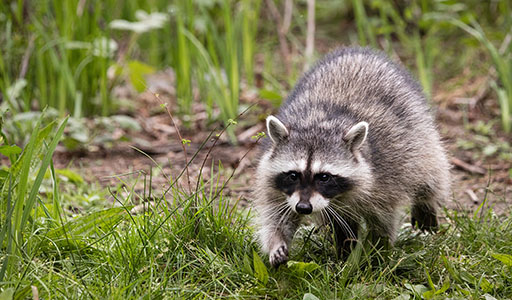Raccoons

Raccoon Information
Raccoons are likely a familiar face to anyone living in North America. These mammals have a very distinct appearance due to the mask of black fur covering their eyes, hand-like paws, and their perpetually hunched-over posture. These features like these have fueled a perception of raccoons being tricksters and mischief makers, one that has persisted since Native Americans first encountered them. Many homeowners will testify that these impressions aren’t too off base, either—raccoons are widely considered pests nowadays, using their considerable intelligence and dexterous paws to wreak havoc on people’s homes.
Much like humans, they have seen a marked population increase in the last century; following a population explosion in the late 1940s, the estimated number of raccoons in North America in the late 1980s was a staggering 15 to 20 times higher than in the 1930s, when raccoons were actually somewhat rare. This abrupt increase in population is largely attributed to urbanization and the expansion of agriculture. Now, these omnivores live all over the United States, and have even been distributed across central Europe and Japan.

What does a raccoon look like?
Raccoons are the largest of the procyonid family, with a body length of 16-28 inches (not including the tail) and a weight of 11-57 lbs. Males (called boars) are slightly larger than females (sows). Five to eight light and dark rings alternate on a raccoon’s tail.
The most distinct physical feature of a raccoon is the area of black fur around the eyes, which contrasts sharply with the surrounding white fur and is often thought to give the impression of a “bandit’s mask.” It is hypothesized that this exists to reduce glare and enhance the animal’s night vision.
Raccoon’s mode of locomotion is plantigrade, meaning they can walk partly or wholly on the soles of their feet with the heel touching the ground. They can also easily stand up on two legs, a posture that makes them appear larger and is thus usually reserved for intimidation. Because its hind legs are longer than its front legs, raccoons often appear hunched over when they walk or run. The five toes on a raccoon’s front paws are extremely dexterous, allowing them to manipulate a variety of objects designed for humans, such as doorknobs, jars, and latches.

What does a raccoon eat?
Raccoons are omnivores in the truest sense of the word—they will eat just about anything, and are very opportunistic eaters to boot. This also means that their diet often depends on their environment. Common foods for a raccoon include fruits, plants, berries, nuts, insects, rodents, frogs, eggs, and crayfish. Raccoons will seldom eat large prey, preferring to hunt prey that is small and easy to catch, like crayfish, insects, amphibians, and bird eggs. Raccoons prey on eggs and hatchlings in both bird and reptile nests so often, in fact, that they often need to be removed from certain areas to mitigate the effects of their predation (this is the case with some threatened turtle populations).
As is probably well known to most homeowners, raccoons living in urban environments have the exasperating habit of sifting through trash cans for a meal. They also routinely dine on crops and eat pet food that has been left out in the open. It is partly due to these habits that raccoons are widely considered pests.

Where do raccoons live?
Raccoons are common in North America from Canada all the way down to Panama. The original habitats of the raccoon are deciduous and mixed forests, but due to their adaptability they have since extended their range to mountainous areas, coastal marshes, and urban areas, where they live with little difficulty. The creatures prefer to live near a water source, such as a stream, lake, wetland area, or slow-moving river, but are highly adaptable and can learn to thrive in a variety of environments. They make dens in hollowed trees, rock crevices, and the abandoned dens of muskrats or similar animals. Previously thought to be generally solitary, there is now evidence that raccoons can live together as a form of sex-specific social behavior: related females often share a common area, while unrelated males often live together in groups of up to four raccoons to protect their positions from foreign males during the mating season, and from predators.
When is the raccoon mating season?
Raccoons usually mate in a period triggered by increasing daylight between late January and Mid-March. During mating season, the males roam their home ranges in search of females in an attempt to court them during the three-to-four-day period when conception is possible; these encounters often take place in established meeting locations. The male does not remain with the female following conception.
Raccoons usually give birth between March and April, but in some cases do so as early as February and as late as July. Raccoons usually have one litter per year of two to five baby raccoons (called kits) per year, although the average litter size varies widely with habitat. Kits are considered weaned around 2-3 months after birth—meaning they are able to survive on their own—but despite this, raccoons usually stay with their mother for about a year before facing the world on their own.
How to Live Harmoniously with Raccoons
Raccoons are intelligent, curious animals that have learned to coexist with humans remarkably well. It is for these reasons that encounter between raccoons and humans are so common.
In most cases, raccoons only become a nuisance if you give them an opportunity to. Like all animals, raccoons seek primarily three things: food, water, and shelter. Avoiding trouble with raccoons, therefore, is mostly a matter of eliminating access to those three things to the greatest extent possible. Store all food that raccoons could conceivably get to—especially pet food—in sealed containers, and keep trash cans and compost heaps well covered. Containing food in this way should encourage raccoons to move on. Also, seal or cover any entry points, such as pet doors, vents, or your chimney. Another good idea is to cut back overgrown trees and bushes that raccoons could use to climb onto your house—you might even make your yard look better in the process.
Of course, if the raccoons on your property begin to live up to their reputation as pests, there are a few measures you can take. One of them is mild harassment techniques.
These are harmless, easy ways to dispel unwanted wildlife:
- Light. Since they are primarily nocturnal animals, raccoons don’t like excessive light. Simply aiming a flashlight at their den and leaving it there will likely convince the raccoon that the area isn’t safe, prompting them to relocate.
- Sound. Grab a radio and place it near the den’s entrance. Interestingly, raccoons have a greater tolerance for the sound of music than they do for human voices, so tune it to an all-talk show, and consider warning your neighbors if you think it might be an annoyance.
Note: Whichever technique you choose, be sure to turn off the device periodically, The MSPCA recommends that you turn these devices off periodically, so the mother will feel safe to re-enter to retrieve her young.
If you suspect you have a serious raccoon problem, or you simply don’t want to spend your time fiddling with traps or repellants, you shouldn’t delay in calling a wildlife removal expert. These animals can be incredibly destructive and carry diseases like rabies, canine distemper, and roundworms. Our team at Trutech Wildlife Service can remove these masked mammals from your property quickly and ethically.
Frequently Asked Questions
A baby raccoon is called a kit. These pests mate in winter and give birth by late spring. Being born so early in the year gives kits a chance to build and store plenty of fat to survive the winter.
Raccoons give birth to a litter of two to seven kits that rely on their mother for food and shelter. This is why finding a female together with her young in the attic or yard is not uncommon. Baby raccoons have trouble surviving through their first winter if they don’t get enough food during warmer seasons.
Urban and suburban areas are hotspots for raccoons. Kits often hide in dens under houses, sheds, or other structures while their mothers search for food. These animals gather trash and scraps from humans and are often comfortable in populated areas.
As temperatures drop, raccoons develop a heavier coat and consume as much food as possible to ready themselves for winter. Developing a healthy layer of fat will insulate them from the cold and provide extra energy when food gets scarce.
Thanks to all of these wintertime preparations, raccoons do not hibernate. They stay active throughout the winter and sleep in raccoon dens only during the worst weather.
In the wild, raccoons sleep in tree hollows, rock crevices, and the empty burrows of other animals. If given the chance, they also nest in chimneys and crawl spaces in urban areas. Raccoon dens serve as a safe resting place for the animals during the day and a home for growing offspring.
Since raccoons eat a variety of foods, their feces or poop may differ in color and consistency. In general, raccoon droppings are about three to five inches long and broken into crumbling segments. Their diameter is close to that of a human pinky finger, while color ranges from light to dark brown. Though their waste may look similar to that of an opossum or fox, raccoon scat has distinct blunt ends. Additionally, the pests create latrines, which they locate some distance from nesting sites. These waste piles can be found around logs, trees, and unfortunately, on rooftops and in attics.
The average raccoon lifespan is about five years, though many kits die before reaching adulthood. The longest surviving wild raccoon lived for 16 years, while a captive raccoon’s lifespan can last as long as 21.
Being able to identify raccoon tracks can help homeowners understand if their homes or yards are at risk. As the pests cause property damage, infest homes, and carry diseases, it is imperative to spot an infestation early. Raccoon track identification begins with checking the size and shape of animal prints.
These pests have five toes on each foot, so their tracks resemble the handprints of a small child. Front prints are about two and a half inches long, and hind prints often measure up to three and a half inches. Raccoon tracks usually appear in pairs, as their hind foot moves beside the opposite forefoot while walking.


